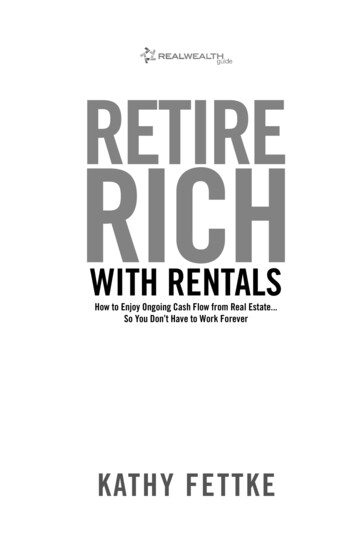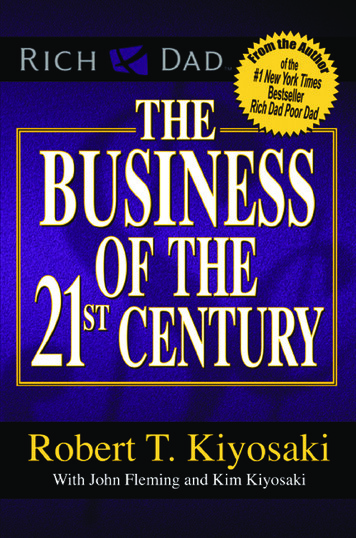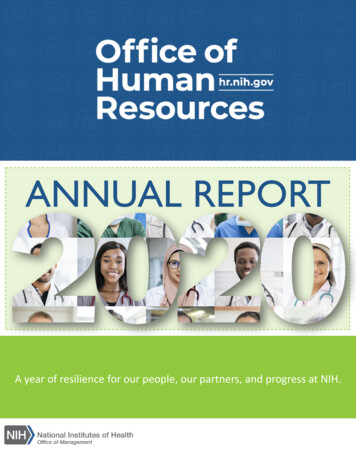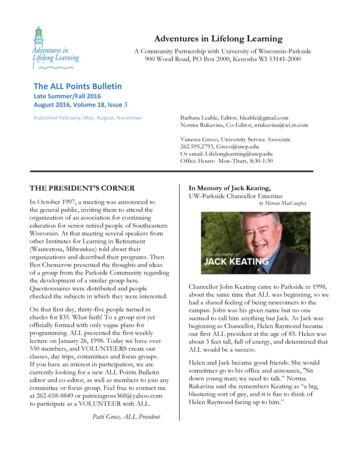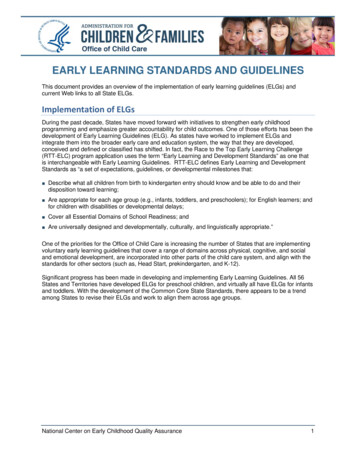
Transcription
Steps to plan & achievefinancial independencefreefincal.com
PrefaceEarly retirement or financial independence is the holy grail ofmost salaried employees today. This e-book is an as-iscompilation of seven posts on early retirement fromfreefincalcom.Early retirement in India is quite different from what is discussedat popular US blogs like ERE and MMM. It is quite easy tocalculate with a high real return (excess return above inflation)and arrive at a pleasing corpus. However early retirement isfraught with many dangers. High inflation and an unluckysequence of returns from equity can spell disaster. Therefore isit is extremly important to err on the side of caution. Thiscompilation is an attempt to highlight such issues while alsoproviding a list of tools to plan and track your early retirement.Since it is an unabridged compilation, apologies if it is in yourface and abrupt.Do let me know if you have any feedback: freefincal@gmail.com
nning-a-slide-show/Retirement Planning – A Slide ShowHere is a set of slides on retirement planning that I have used at the investor workshops. The aim is to convey theimportance of retirement planning in a few slides to young earners.1. Imagine how your monthly income will evolve in the futureThe abrupt stoppage in income represents retirement.2. Now imagine how your monthly expenses will evolve in the future1/8
Obviously expenses do not stop when income stops. So those who do not have the means to account for expenseswhen income stops, better hope they are dead on or before retirement!The expenses in the above graph seem to head for the roof. Let us rescale it over our expected lifetime.In about 15 years after retirement, the monthly expenses, thanks to inflation is higher the last drawn pay!2/8
Meaning, if I had an (imaginary) monthly pension that equals my last drawn pay, I will only be financiallyindependent for about 15 years after retirement. So we need to do a lot better!The sad truth is actual pensions (be it from a pension plan or employer-provided annuity) are much, much lowerthan the last drawn pay. Something like this.3/8
Therefore, for your own sake, eradicate the concept of a 'pension' from your minds.Instead, think: Inflation-protected income (blue dot within the red circles, below)To generate this inflation-protected income, you need a corpus that is anywhere between 25-35 times (dependson inputs) your annual expenses at the time of retirement (the earliest green dot). As you withdraw more and morefrom the corpus, it decreases and drops to zero hopefully when you die, and only when you die. Ensuring this, isthe third stage in retirement planning.The second stage is to ensure our investments grow and hits the first green dot, when we retire.4/8
We need to do two things to grow the corpus. 1. Choose a productive, but diversified portfolio; 2. InvestOne cannot choose to invest a constant sum because, the monthly investment to be made immediately will be much5/8
larger than monthly expenses. The above graph has a logarithmic y-axis and hence the lines appear linear.To ease our burden, we can instead choose to increase out investment each year from now until retirement.This would imply we must strive to invest as much as spend.This is easier said than done. Let us have a look at the second graph again6/8
In this picture, the gap between the monthly salary and monthly expenses increases as we approach retirement. Ifthis is how our lives pan out, then we can mange to invest as much as we spend with a little effort and discipline.Unfortunately,7/8
Our expenses tend to grow in steps as shown in green above. Call it lifestyle creep if you like. If we embrace everynew technology that arrives, if we cannot distinguish between our needs and wants, if we succumb to peer pressureand buy what others buy, we will never be able to invest enough.Meaning, we are sowing the seeds for our future financial doom today.Lifestyle creep, the desire to spends for today and enjoy when young, resides in all of us. What is needed is adefinite boundary: We can spend the way, we wish as long as we can manage to invest as much as we can spend.Safeguarding that boundary is the first and foremost step of retirement planning.If you want to get started with your retirement planning, do give this a try: The low-stress retirement calculator(hopefully!)8/8
nt-india/Is it possible to retire early in India?Is early retirement in India possible? Can a 45-year-old with ‘enough’ saved up, hang up his boots and avoid a fulltime job for the rest of his life?In this post, I do a feasibility study considering three different scenarios for early retirement to determine the mostpractical approach.Early retirement is a phrase that has become extremely popular in recent year thanks to successful blogs likeEarly Retirement ExtremeMr. Money MustacheGetrichslowlyThe Simple Dollarand many more that have cropped up by inspiration.Many Indians get inspired by these blogs and seek early retirement without understanding the implications ofinflation levels in India and what it actually means to a retirement plan. Some even have designed retirementcalculators ignoring post-retirement inflation!No one seems to understand how fragile their plans look on paper. So this post is to debunk some popular notions onearly retirement and to provide a reasonably practical solution.Early retirement is an extremely common dream. You long to say good-bye to your tough corporate job, tell your evilboss to f%%% off, begin an entirely new phase in your life!Almost everyone dreams it, but only a few people decide to do something about it. Will those few succeed? Howpractical is it to retire early in a country where inflation is close to double digits?Let try and answer these questions in this post by taking the case Brainy Smurf. Regular readers may recall weconsidered Grouchy Smurfs retirement planning with fixed and recurring deposits.Brainy Smurf is a nerd who loves numbers. He would like to meticulously plan his retirement before quitting his job.He is convinced that with a frugal lifestyle and intelligent investing, he will be able to retire early in India.1/13
Brainy Smurf explaining to Papa Smurf about early retirement while inflation is preparing to strike! Photo Credit: VikNandaOpens in a new windowNote: Although this post considers early retirement is meant for everyone. All of us should understand why it iscrucial to plan for retirement as early as possible and invest as much as possible – preferably, as much as youspend!This is a lengthy post where we consider different scenario cash flow charts with graphs. I would like the reader toobserve the cash flow charts and make their observations.If you are serious about early retirement, you will need to spend extra time with the charts.Let us now run through Brainy Smurfs numbers and check see where he stands.Age at retirement: 45Years in retirement: 45! (He assumes he will live up to 90)Monthly Expenses: 20,000 per month. This is much lower than most Indian households. When you reach the endof this post, recall this fact and figure out what would the situation if monthly expenses are higher than this!Annual Expenses: 20,000 X 12 20,000 2,60,000. We add an extra months expenses to account for healthinsurance, and other annual expenses. We are going to use these inputs in three scenarios:1. The Income drawdown strategy (decreasing corpus)2. The constant withdrawal rate strategy (increasing corpus)3. Using a perpetuity (constant corpus)Accounting for the unexpectedScenario I: The Income drawdown strategy (decreasing corpus)Inflation: 8%. Return expected on retirement corpus 8%. The real return is zero. That is our annual return isequal to the average rate of inflation. Using the "how much is required to retire?" tool, we find that the corpus2/13
required is 1,17,00,00 or 117 Lakhs. Here is how the cash flow chart would pan out.3/13
Notice how the corpus initially increases and then decreases when expenses become high due to inflation.It becomes zero after 45 years. This is known as an income drawdown strategy. Brainy allows his corpus to grow atsome rate (8% in this case) and withdraws from it each year to handle his expenses that increase each year withinflation (8% in this case).The real rate of return (1 return)/(1 inflation)-1 0%Notice how the withdrawal rate expenses/(corpus value @ year start), rapidly increases.Myth: Withdrawal rate is a constant4/13
Truth: Withdrawal rates are constant only if you plan for them to be so. In a drawdown strategy, the withdrawal ratecannot be constant even if inflation is assumed to be zero!Scenario II: The constant withdrawal rate strategy (increasing corpus)In this case, the percentage Brainy withdraws from a corpus at the start of each year is assumed to be a constant.That is Brainy will need 2,60,000 in the first year of retirement. So assuming a withdrawal rate of 3%, he will need acorpus of 86.7 Lakhs to start with.Notice this is considerably lower than the 117 Lakhs need in the drawdown strategy.If inflation is assumed to be zero and for 3% withdrawal rate each year in retirement, brainy Smurf will only need areturn of 3.1% on his corpus.His corpus will not reduce in value and will remain 86.7 Lakhs after 45 years! Since inflation is zero, the real return return 3.1%For an inflation of 3%, the return required 6.2% and real return 3.1% for each year in retirement to maintain thewithdrawal rate constant at 3%For an inflation of 8%, the return required 11.34% and real return 3.1% for each year in retirement to maintainthe withdrawal rate constant at 3%This is how the cash flow chart looks like5/13
The top cell in the withdrawal rate column is green to signify that it is an input. This is how the corpus grows withtime.6/13
Lower the withdrawal rate, higher the initial corpus required lower the return.For example, for a withdrawal rate of 5%, Brainy would need only 52 Lakhs to start with, but require an annual returnof 13.7%For a withdrawal rate of 1%, Brainy would need only 260 Lakhs to start with, and required an annual return of 5.3%.(Thanks to Satish for pointing out a mistake here)So he needs to find an optimum withdrawal rate to keep the initial corpus and return required low.However is this scenario practical? Can you manage a real return of 3.1% year after year for the kind of inflation thatexists in India? Many of the early retirement fans seem to think it is not such a big deal!Have to find out what they are smoking! One could argue that a real return need not be obtained each year inretirement, and it is some kind of average after a few years.Point taken. However, we are talking the return for the entire corpus to grow. So even if we invest part of the corpusin equity and part in debt, how practical is to achieve an average real return of 3%? This would mean much of thecorpus will have to be in equity.So a couple of bad years and Brainy would be screwed.They also talk of something called a safe withdrawal rate(SWR). This is the rate at which one can withdraw from acorpus taking into account volatility in its growth rate and inflation. All this talk of SWR is impractical in a highinflation rate scenario.What one needs is a Safe rate of return. That is, before we actually retire, we should plan with a volatility-free return,that can be realistically achieved year after year in retirement.7/13
After we retire, we should divide the corpus in different buckets and allow them to grow at different rates. Eventhen, the net portfolio return has to be realistic!Resigning our job in the hope of achieving an unrealistic high net portfolio returns is madness.Retirement math is simple. No matter when you retire, the math is the same. It is neither shocking simpleOpens ina new window, not alarmingly complex. You do not need concepts like SWR.Prepare for the worst and pray for the best. To assume that withdrawal rate ( SWR) will be constant in retirement,for high inflation scenarios is plain dumb in my opinion. I will leave you to be the judge.Scenario III: Perpetuity (constant corpus)Perpetuity is nothing but an pension or annuity that is constant and forever. Such annuities are sold by insurancecompanies and last until the lifetime of the retiree.If you want one to last forever (that is outlive you) your corpus will have to increase each year by the exact sameamount that you withdraw.Then the corpus will never diminish like it does in a drawdown strategy (scenario I), nor will it increase like theconstant withdrawal rate strategy (scenario II).When inflation is zero, scenarios II and III become identical.Now with 8% inflation, if Brainy uses 117 Lakhs as the corpus required (same as scenario I), this how the cash flowchart pans out8/13
The green cell indicates that corpus is an input in this case. Although the corpus is constant, notice the returnrequired.9/13
Notice the return required is low initially and the rapidly increases. Therefore, for nearly 20 years the real return isquite small and in fact negative for several years initially.After that it is impractically large! So assuming again the idea of a perpetuity as it is defined will not work in a highinflation rate scenario.Hey! Wait a minute, the return required for the first several years is too small. Why can’t Brainy assume a higher rateof return? He sure can!Only that it will not become a perpetuity then.For example. If the rate of return required is an achievable 8% ( inflation rate) for all 45 years, then you will simplyreproduce scenario I. That is the corpus will reduce to zero.If you take the rate of return is higher than the inflation for all years in retirement, you will reproduce scenario II: thecorpus will increase. Again, the question of how practical this is, looms large.Mixed Bag ScenarioWhat if we combine Scenarios I and III? That is choose 10% as required return for first 20 years in retirement (realreturn 1.85%, still a tall order but barely manageable), 8% as required return for next years (real return is zero sinceinflation is 8%) and then plan for a perpetuity. That is we choose scenario I for first 25 years in retirement and then switch to scenario III for the last 20 years.10/13
Here is the cash flow chart11/13
The green cells as usual represent the variables. Notice that return required is now just about manageable foralmost 41 years in retirement. That is a reasonably good achievement.Notice how the scenarios are combined. We have used the fact that the corpus grows in the initial phase of scenarioI and combined it with the constant corpus perpetuity in scenario 3.The region in scenario I when the corpus starts to decrease has been avoided. This provides a reasonablymanageable scenario. The starting corpus used is the same as in scenario I: 117 Lakhs.Scenario IV: Accounting for the unexpectedPhew! If you have made it to this point, thank you very much!Now, all of the above are scenarios on paper. Life does not work quite like that.12/13
Trouble with the early retirement extreme folk (including Brainy) is that they think frugality and DIY can solve allproblems of life. This is nonsense.You may want to be frugal, but life may not allow you to do so. You may think you have your expenses in controlwhen an unexpected recurring expense can wreck havoc on your plans.Banking on frugality to defeat inflation is dumb. Yes, frugality will help you combat inflation but you will also have totake into the ups and downs of life. I can tell you with the full benefit of hindsight that a frugal lifestyle has helpedme keep expenses in check. I cannot however assume that it will continue to remain the same.I may buy only what I need, but that can change with time!We have already discussed the trouble with banking on real returns after retirement.So what does this mean for Brainy? What scenario should he choose?Brainy should plan with a drawdown strategy – this is the standard used in all retirement plans. When it comes toimplementation he should choose the bucket method which in some sense a variation of the mixed bad scenariodiscussed above and try to prolong the life of the corpus as much as possible without taking undue risks.Bottomline: Do not hate your job too much! If you are not assuming realistic rates of return and inflation, you will notable to retire as early as you think.Besides if you don’t know how to spend your time in retirement, why bother retiring? Your time would be better spentinvesting wisely and enriching your skill set.Dear Brainy Smurfs, Get real!Do not retire early if your corpus is lesser than that given by the drawdown strategy with reasonable inputs.What do you think? Do you think it is possible to retire early in India?What if the expenses were higher than that assumed here?13/13
need-to-retire-early-in-india/How much do I need to retire early in India?A look at 'how much' or 'what is the corpus required for early retirement in India?'. I had earlier written a detailedpost on this subject and the common misconceptions youngsters seeking financial freedom form after reading blogslike ERE and MMM.The central message of that post was, early retirement is possible, but one must have a comfortable corpus takinginto account the high inflation levels in India. Unfortunately, many people misunderstood it and assumed that Imeant early retirement is not possible. Either before or after reading this post, I strongly suggest you read that oneas well: Is it possible to retire early in India? Opens in a new windowOver the past few years, I have reviewed 5/6 portfolios of early retirees and discussed their views of risk and reward.All of them, have huge margins of safety when it comes to estimating the retirement corpus (which is an annualexercise before and after retirement. See why hereOpens in a new window)Personally I have similar if not higher margins of safety. I am not desperate for financial independence but do seek itaggressively. With a simple MDBSC approach in mutual funds, and with copious amount of luck, I might get therebefore I turn 50: Retirement Planning: My Story So FarOpens in a new windowThe reason I state the above is, "margin of safety" depends on the age of the person. It is hard to convince a 25year-old kid who has not seen the vicissitudes that assuming a 4% alpha after retirement like Mr. MMM advocates,can be suicidal or having 80% equity after retirement to compensate for a low corpus, completely ignores theimportance of sequence of returns.It is obvious that bad experience is a great teacher. Almost a decade ago, while I was waiting to be interviewed formy current job, I met my teacher and told him about my hardshipOpens in a new window after my father took ill.He said, "you should be happy that you are going through this when young. Will give you a lot of strength". I was 31then and thought it was bollocks. At 40, considering what I experienced afterward, I believe those are golden words.My point is, while retiring early it is extremely important to account extreme situations and that comes with ageand/or experience.Let us go through an early retirement planning calculation to illustrate my point.Consider an individual (or couple) who is(are) planning for 40 years in retirement.Zero real returnIf their current expenses are say, Rs. 3,60,000, then, for an assumed 7% yearly increase in pension (due toinflation) and for a conservative (but safe) post-tax return of 7% from the entire portfolio (zero real return), thecorpus required is 1.44 Crores (40 times annual expenses at retirement)1% real returnSame assumptions as above, but now with 8% post-tax return from entire portfolio ( 1% real return), the corpusrequired is 1.20 Crores (33 times annual expenses at retirement)2% real returnSame assumptions as above, but now with 9% post-tax return from entire portfolio ( 2% real return), the corpus1/4
required is 1.02 Crores (28 times annual expenses at retirement)3% real return -- 88 Lakhs (24 times annual expenses at retirement)4% real return -- 76 Lakhs (21 times annual expenses at retirement)What would you do if these were your numbers?My view of early retirement is simple: I should have enough so that I don't have to work again. I might take up parttime assignments, but I should not be dependent on this income.I will sleep peacefully if I can retire with 1.44 Crores. If I hate my current job, I will probably retire with 1 crore (2%real return). Dangerous to assume a real return above that.Let us see how one can pull off early retirement with 2% real return (some luck is necessary in this case though).Suppose my retirement corpus is X. I divide the corpus into 4 parts.X A B C DA -- invested in fixed income assets (7% post-tax) and used to generate income increasing at 7% a year.A 10 times the annual expenses in 1st year.B, C and D are invested in a portfolio with 60% equity (12% return) and 40% debt (7% post-tax)B is invested for 10 years. After which it is taken out and used to generate income for years 11 to 20 in the samemanner as A.C is invested for 20 years. After which it is taken out and used to generate income for years 21 to 30 in the samemanner as A.D is invested for 30 years. After which it is taken out and used to generate income for years 31 to 40 in the samemanner as A.2/4
Note: return assumptions are invalid over a 40-year period, but since they are reasonable wrt initial years, I think it isnot terrible. In any case, one can easily rework with lower returns from both equity and debt down the line.This strategy is equivalent to an overall real return of about 2%. So if the couple has a corpus which is more than28 times (preferably 30) current annual expenses, it is reasonably safe for them to retire.What can go wrong with this plan?1) Extended sideways market (bad sequence of returns)2) unexpected recurring expenses3) inflation higher than expected.How do you safeguard yourself against such circumstances? With age, we realize that the best way to handle thisis to have a slightly larger corpus to begin with.My take: Work with min 7-8% inflation (I work with 9%) and not more than 2% real return (I work with zero realreturn). Do not decide to retire unless you have a corpus that is at least 30 times your current annual expenses.This early retiree checks each year if his corpus is 35 times annual expenses: Achieving Financial Independence:A Forthright InterviewThe above illustration can be downloaded from here: Early retirement illustrationThis is only an illustration and not a calculator. If you want to make changes, you need to know how the sheet iswritten.If you want a calculator, try this: Inflation-protected Income Simulator3/4
You can also consider checking out these posts:Generating an inflation-protected income with a lump sumIllustration: Generating inflation-protected post-retirement income4/4
o-lower-your-retirement-corpus-2/Retire early to lower your retirement corpus!The sooner you retire, lower the retirement corpus necessary for financial freedom!** terms and conditions apply!Let us consider this counterintuitive aspect of retirement calculators in this post, which stems from SudhindraAithal's comment on this topic in response to the low-stress retirement calculator.Let us consider a 30-year-old, Dagwood Bumstead who wishes to plan forretirement. For those who may not know, Dagwood is the husband ofBlondie - a long running comic strip!He wants to decide the age at which he could retire. Since there are (too)many parameters in a retirement calculator, Dagwood wishes to keep thefollowing inputs fixed:1. Inflation before and after retirement: 8.5%2. Life Expectancy: 903. Return expected on retirement corpus: 9% A real return of 0.46% (not0.5%!!)If Dagwood wishes to retire at 65 (25 years in retirement), he wouldneed a corpus of 14.8 Crores.If he prepones his retirement to 60(30 years in retirement), he wouldonly need 11.8 Crores.If he wishes to retire even earlier at 50 (40 years in retirement), hewould only 6.7 Crores. More than 50% reduction for 15 additionalyears in retirement!!!Used for illustrative purposes only. Nocopyright infringement intended.At first sight this is astounding! The longer Dagwood needs to live in retirement, lower is the corpus he needs!The reason for this is the interplay between negative and positive compounding.Negative compounding refers to the effect of inflation and positive compounding refers to the grow rate of theretirement corpus.The sooner Dagwood retires, lower would be the expenses at the start of retirement. If he retires at 50, his expenseswould be about 30% lower than at 65 (the projected value).Meaning, he would withdraw less from his corpus. Therefore, more of the corpus can grow.Thus, he needs a lower corpus at 50 than he would at 65!This bizarre but easy to understand idea, is illustrated below.1/3
The retirement corpus initially increases because the growth is higher than withdrawals. Soon due to inflation, thewithdrawals exceed the growth. Therefore, the corpus peaks and then rapidly falls with each additional year inretirement to zero (at age 90 in each case).Earlier the retirement or more the years in retirement, the longer it takes for the corpus to peak and then fall. That isthe annual growth of the corpus is higher than the annual withdrawals for more number of years. This is why onecan do with a relatively lower corpus (vertical dotted arrow).This aspect can also be illustrated by compared the retirement corpus required for different retirement age and theexpenses in the first year of retirement.Higher the retirement age, higher the corpus because of higher the initial expenses.Where is the catch?This does not mean that one can retire early!! Although a lower corpus is required, the time needed to accumulate itis also lower.2/3
That is, there is not enough time for Dagwoods monthly investment to grow! To offset this, Dagwood will need toincrease his monthly investments.Lower the corpus required, higher the monthly investment! In fact, the investment rapidly increases with decrease inretirement age and soon become impractical. This is calculated assuming Dagwood has not made any investmentso far.Thus, if Dagwood wishes to retire at 50 rather than 65, his monthly investments should more than double (while hiscorpus is less than half!).Moral of the story: No free lunch!3/3
-your-retirement-withdrawal-rate/What Should Be Your Retirement Withdrawal Rate?March 17,2013Manish Chauhan's second book, "How to be your own financial planner in 10 steps" is a great 'action' bookguiding people through the basic steps of financial planning. This post describes a retirement calculator inspired bythe book and is based on 'corpus withdrawal rate'Step no. 6 is "Start your retirement planning". In this chapter Manish writes: "If you had to take only one learningfrom this book and implement it, I would suggest that you take this particular point from this book and seriouslysave for your retirement. If you don't do anything else, life will still move on, but this particular part cannot beignored, simply cannot!". The 'point' being, 'delaying your retirement planning will put serious pressure on yourretirement life'.When I made the cost of postponement calculator (again a suggestion by Subra!) I was surprised to see that thatthe cost of postponement is deadlier than inflation. Each year you postpone saving for retirement the amount youneed to save each month for building your retirement nest egg increases by an alarming 16% - the power ofcompounding has a dark side! This is almost twice as much as inflation!The chapter on retirement planning is quite impressive and the all-important, "How much will you need at retirement"is addressed in terms of the 'withdrawal rate'.What is the withdrawal rate? If I have a corpus of 5 crores and if my annual expenses amountto 12 lakhs, the withdrawal rate is 12/500 or 2.4%. This the rate for the first year of retirement. What about thesecond year and later? The withdrawal rate (lets denote this by w) is not a constant. It depends onthe rate of inflation during retirement (i)the rate of return on the corpus ( r)duration of retirement ( k)This is the formula connecting w,i,r and k (feel free to ignore it if math nauseates you!)It is often assumed that the withdrawal rate for the secondyear will increase with inflation. That is if inflation is 8%then w(2nd year) 2.4%X(1 8%) 2.6% and so on.However this is not true and the above formula has to beused.This is how the withdrawal rate typically looks for each year in retirement. The initial rate (for 1st year) is 3.5% in thisexample. (Click on the picture for a clearer view)1/3
Safe to say that the withdrawal rate changes with time in a complicated way! The point is, only the withdrawal ratefor the 1st year in retirement or the initial withdrawal rate can be guessed (along with other assumptions: at leasttwo out of i, r and k). The withdrawal rate for subsequent years should not be guessed and has to be computedusing the above formula.Here are some further insights about the initial withdrawal rate (Click the pictures for a clearer view)How long the corpus lasts depends on whetherreturns can beat inflation or not. For a 4% initialwithdrawal rate and 8% post-retirement inflation, ifreturns are 2% above inflation the corpus will fornearly 33 years. However if returns are 2% belowinflation the corpus will last only for about 21 years.This will make a huge difference for a person whoretires in his/her mid-50s.2/3
Suppose we plan for 25 years in retirement and assume 8% post-retirement inflation
Many Indians get inspired by these blogs and seek early retirement without understanding the implications of inflation levels in India and what it actually means to a retirement plan. Some even have designed retirement calculators ignoring post-retirement inflation! No one s

